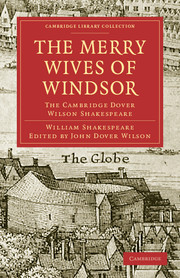INTRODUCTION
Published online by Cambridge University Press: 07 September 2010
Summary
Shakespeare wrote for the stage: and on the stage, in spite of many loose ends in the dialogue and (still worse) in the intrigue, The Merry Wives of Windsor seldom misses to please an audience or to justify itself as one of the briskest, heartiest and most playable of comedies. It has had less luck in the library, the majority of its editors having taken it at once too seriously and not seriously enough: too seriously, being preoccupied with the text (one of the most tantalising in the whole canon) and with two famous legends which have attached themselves to the play; and not seriously enough, being prejudiced by one of these traditions—that The Merry Wives was a slight thing, turned off in a hurry to fulfil a royal command—and using this prejudice to explain their disappointment that its Falstaff does not satisfy their ideal conception of Falstaff derived from King Henry IV, Parts i and ii. For example Maurice Morgann, who in 1777 published a famous Essay On the Dramatic Character of Sir John Falstaff, simply ignored this play: which must mean that he found in it no significant portrayal of the man, or, at any rate, none congruent with the Falstaff of King Henry IV.
We shall deal in due course with the legend which connects the opening lines of our play with a deerstealing escapade for which Shakespeare in his youth had been (so the story runs) put to the law by Sir Thomas Lucy, Knight, of Charlecote near Stratford-on-Avon; its interest being personal and almost quite extraneous from our consideration of the play and its merits.
- Type
- Chapter
- Information
- The Merry Wives of WindsorThe Cambridge Dover Wilson Shakespeare, pp. vii - xxxixPublisher: Cambridge University PressPrint publication year: 2009First published in: 1921



